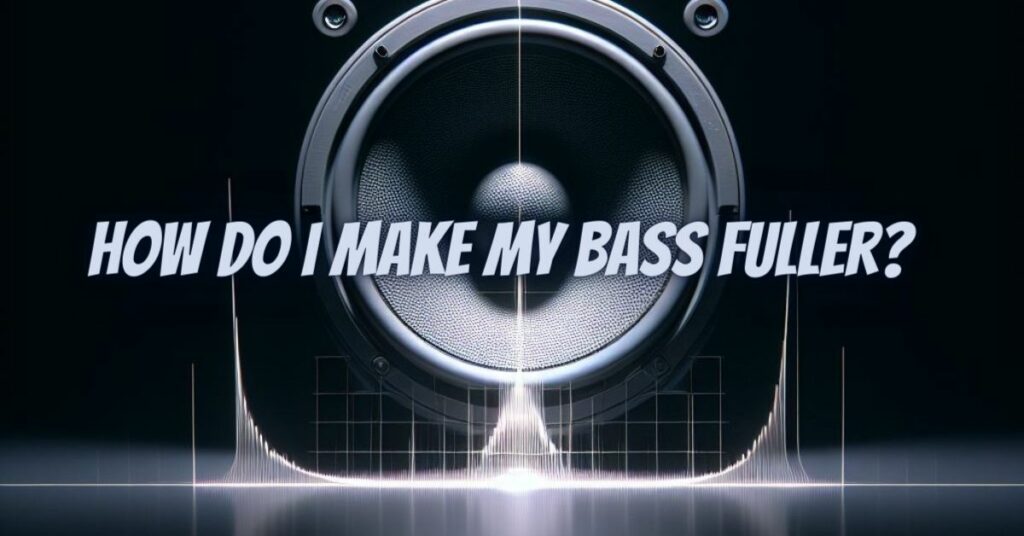A full and lush bass adds richness, depth, and warmth to your music or audio. Whether you’re a musician, audio engineer, or simply a music enthusiast, achieving fuller bass is a goal that can elevate your sonic experience. In this comprehensive article, we will explore various techniques and strategies to help you make your bass sound fuller, ensuring that your low-end frequencies resonate with depth and character.
Understanding the Importance of Full Bass:
Full bass is a critical component of any audio composition, providing a solid foundation and enhancing overall sound quality. Achieving a fuller bass response involves optimizing various aspects of your audio setup, from sound source selection to mixing and post-processing.
1. Source Selection and Sound Design:
The process of creating full bass begins at the source. Whether you’re working with live instruments, synthesizers, or sampled sounds, consider the following:
- Instrument Choice: Select instruments or sound sources that naturally produce rich bass frequencies. For example, certain bass guitars, synthesizers, and acoustic drums can provide a strong bass foundation.
- Sound Design: When synthesizing bass sounds, design patches that emphasize the fundamental frequencies and harmonics. Adjust envelope settings to control the attack, sustain, and release, ensuring that the bass sound is well-defined and full.
2. Equalization (EQ):
EQ is a powerful tool for shaping the tonal characteristics of your bass. To achieve fuller bass, consider these EQ techniques:
- Low-End Boost: Use a low-shelf EQ to boost the frequencies below 100Hz. This enhances the bass’s depth and presence.
- Cut Unwanted Frequencies: Identify and cut any unwanted frequencies that may clutter the low end, such as muddiness in the 200-300Hz range. Removing these unwanted elements can make the bass sound cleaner and fuller.
- Harmonic Enhancement: Experiment with EQ settings to emphasize harmonic frequencies, which can add warmth and character to the bass.
3. Layering and Doubling:
Layering multiple bass elements or doubling the bassline with different instruments or octaves can create a fuller and more complex bass sound. Be mindful of phase cancellation issues when layering to avoid unintended reduction in bass response.
4. Compression:
Compression can help control the dynamic range of your bass, making it sound more consistent and fuller. Apply gentle compression with a low ratio to ensure the bass retains its natural dynamics while taming peaks.
5. Saturation and Harmonic Exciters:
Saturation and harmonic exciters can add harmonics and warmth to the bass, making it sound fuller. Experiment with subtle saturation and harmonic exciter plugins to enhance the low-end character.
6. Subharmonic Synthesis:
Subharmonic synthesis plugins can generate additional sub-bass frequencies below the original bass notes. This technique is particularly useful for creating a deep and full low-end presence.
7. Arrangement and Frequency Separation:
Consider the arrangement of your tracks and ensure that different elements have their space in the frequency spectrum. This prevents overcrowding in the lower frequencies and allows the bass to shine through.
8. Monitoring and Room Acoustics:
Invest in high-quality studio monitors and ensure that your listening environment has proper acoustic treatment. Accurate monitoring and acoustics enable you to make informed decisions about bass enhancement during the mixing process.
9. Mixing and Panorama:
During the mixing stage, pay attention to the panning of bass elements. Ensure that the bass is centered and balanced in the mix, creating a solid foundation.
10. Subwoofer and Speaker Choice:
Choosing the right subwoofer and speakers that can reproduce low frequencies accurately is essential for achieving full bass. Consider investing in quality equipment that complements your bass-heavy content.
Crafting fuller bass involves a combination of sound source selection, sound design, EQ, compression, layering, and post-processing techniques. It’s a creative and technical process that requires careful attention to detail and an understanding of how different elements interact in the frequency spectrum. By implementing these techniques and experimenting with various approaches, you can create bass that resonates with depth, character, and richness, enhancing the overall impact and emotion of your audio compositions.


